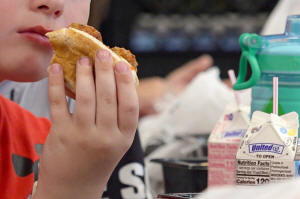West Virginia scrambles to strip artificial dyes from school meals
before classes start
[August 01, 2025]
By JONEL ALECCIA
When school starts in West Virginia next month, 240,000 students in
districts large and small will notice something missing from their
cafeteria trays.
Gone will be red Jell-O fruit cups, yogurt topped with brightly hued
sprinkles and and older verisons of Cool Ranch Doritos — all foods made
with synthetic dyes.
In their place will be foods that contain colors made only from natural
sources — such as vegetables, spices and seeds — after West Virginia
Gov. Patrick Morrisey signed a sweeping new law in March banning seven
artificial dyes from school meals.
Other states have enacted similar laws that would strip artificial dyes
from school meals, but West Virginia’s action is the first to take
effect, starting Aug. 1. It triggered a four-month sprint that that left
state and local nutrition directors reeling.
“I think the initial reaction was like, ‘Wow, what are we going to do?’”
said Tony Crago, director of child nutrition for the West Virginia
Department of Education. “Where do we start?”
Across the state, managers of school food programs scoured district
grocery lists for dozens of products that contained any trace of
petroleum-based synthetic dyes including Red 3, Red 40, Yellow 5, Yellow
6, Blue 1, Blue 2 and Green 3.
“When it went into law, it was shocking,” said Diane Miller, who leads
child nutrition and food services for Kanawha County Schools in the
state’s central region. “We began to realize that these dyes were in
much more than just your cereals.”
West Virginia’s ban on synthetic dyes was cheered by Health Secretary
Robert F. Kennedy Jr., who has successfully pressured food makers to
agree to remove artificial colors from their products. The law focuses
first on dyes in school foods, followed by a second action that will ban
the colors plus two preservatives from all foods sold in the state
starting in 2028.

The move is aimed at halting potential health effects from the dyes,
which have been linked to neurobehavioral problems, such as
hyperactivity and attention problems, in some children. It’s part of a
larger focus on limiting artificial ingredients in food, Morrisey said
in March.
“By eliminating harmful chemicals from our food, we’re taking steps
toward improving the health of our residents and protecting our children
from significant long-term health and learning challenges,” he said.
Health advocates have long called for the removal of the dyes, citing
mixed evidence of potential harm. The U.S. Food and Drug Administration
has said the color additives are safe when “used properly,” in the
amounts and products approved by the agency. Most children have no
problems when consuming the dyes, the agency adds, “but some evidence
suggests that certain children may be sensitive to them.”
More recently, however, FDA Commissioner Marty Makary has joined Kennedy
in the push to get artificial dyes out of food, despite limited proof of
health effects.
“When you get rid of petroleum-based dyes, kids aren’t gonna all
suddenly be healthy,” Makary said on a recent podcast. “We’re not going
to address the fact that 30% of our nation’s kids have prediabetes by
simply removing petroleum-based food dyes. But these are steps in the
right direction.”
Nutrition experts agree that removing artificial colors from foods
doesn’t address the main drivers of America’s chronic health problems.
Those stem largely from ingredients such as added sugars, sodium and
saturated fat.
[to top of second column]
|

In this image from video, a student eats a meatball sub sandwich
during lunch in Parkersburg, W.Va., on Wednesday, July 9, 2025. (AP
Photo/Patrick Aftoora-Orsagos)
 But dyes are “hallmarks of
ultraprocessed food,” said Jerold Mande, a Harvard University
nutrition expert and former federal food policy adviser. Targeting
them could be a way of letting companies know “that the way they’re
making food is unacceptable,” he said.
Some suppliers had already removed artificial dyes from some school
foods, swapping them for products colored with beet juice or
turmeric, said Hollie Best, food service director for Wood County
Schools in Parkersburg, which has 11,000 children in 27 schools.
Overall, Best said she removed just five foods from her menus.
General Mills said 98% of its products for schools were already made
without the banned colors. The company “will be compliant” with West
Virginia’s law immediately and plans to remove the dyes from school
foods nationwide by next summer, said Mollie Wulff, a company
spokesperson.
In Miller’s district, with 23,000 students in 67 schools, the new
law affects about 10% of the foods served, she estimated. She
expected some foods to contain artificial colors, like strawberry
milk and Pop-Tarts. Others were surprising, such as pickles, salad
dressing and certain snack chips.
“People were like, ‘Oh my gosh, no more Doritos?’” Miller said. The
popular Cool Ranch flavor previously contained dyes Red 40, Blue 1
and Yellow 5. PepsiCo, which runs the Frito-Lay division that makes
the chips, has pledged to remove the synthetic colors starting with
this school year, according to spokesperson Genevieve Ascencio.
The challenge is finding substitutes that will still appeal to
children, Miller said.
“Because the last thing we need them to do is to choose not to
participate in our school lunch program,” she said, adding that
schools provide many students their healthiest meals of the day.
Parents of children with sensitivities or allergies to artificial
dyes had already raised concerns, according to school food
directors. But for others, the presence of synthetic colors in
school meals hasn’t been an issue. Chris Derico, nutrition director
of Barbour County Schools, with 2,000 students, said few parents
seemed worried about dyes.
“They’d be in the minority, I believe,” he said. “In rural West
Virginia, I don’t think it’s really on radar screens.”
In Best’s district, dyes were already out of the food dished up
during the summer session in July. That didn’t make much difference
to Lilith Wilson, 9, who said her meal of a meatball sub sandwich,
sweet potato fries and ice cream was “really good.”
Asked whether she likes school lunches in general, the incoming
fourth-grader echoed the sentiments of picky kids everywhere:
“Sometimes I don’t, sometimes I do. It just depends on what it is.”
All contents © copyright 2025 Associated Press. All rights reserved
 |